

USCG CABLE SHIP PEQUOT - UNITED STATES HARBOR DEFENCES
| The Pequot's Escorts |
This page provides more detail about the U.S. Coast Guard Cable ship
Pequot during World War II.
It tells about the
role and strategic importance of the Pequot's escort ships as she carried
out her vital harbor defense cable-laying program along the eastern seaboard
of the USA. These included: 83 Footers, Submarine Chasers, US Coast Guard
Auxiliary and Patrol Yachts. Our main page for the USCG
Pequot provides extra
details about the ship, its crew, its purpose as well as links to our other
Pequot pages. Research and design by by Chip Calamaio and Richard Walding.
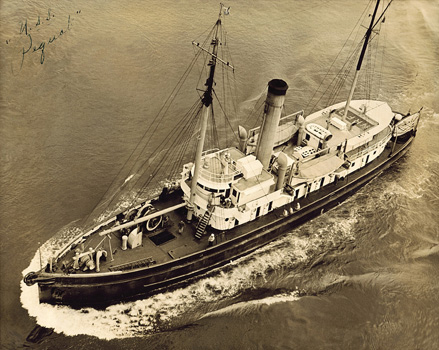 |
|
The US Coast Guard Pequot. During WWII this cable ship laid top secret Indicator Loop cables to protect harbors from German U-boats. Her mission ranged from the ports of Virginia up to Argentia, Newfoundland. (Calamaio family). |
THE ROLE OF THE ESCORTS
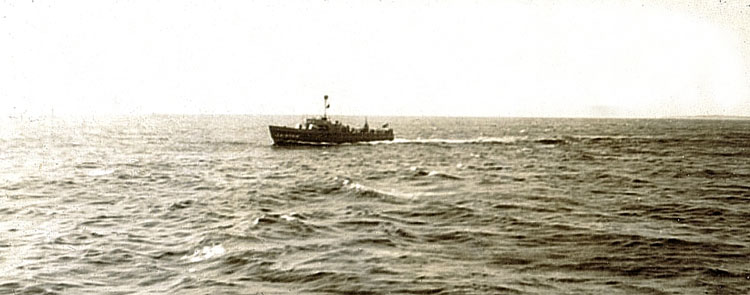 |
In August of 1944 an 83 Footer protects the
Pequot off the Coast of Maine (Roger Calamaio Photo) |
During the installation of anti-submarine indicator loop cables, and while laying and servicing standard communications cables, the Pequot moved very slow or was stationary. Primarily based out of Boston or New York, a variety of escort vessels were assigned to protect Pequot during these operations throughout the war.
When the convoys were forming up off the North Atlantic coast of America for the supply runs to England and Murmansk, Russia anchors from the supply ships would often snag indicator loop and communication cables and break them. The Pequot would have to find and retrieve both cable ends and make repairs. It was very tense because the ship and crew would be sitting dead in the water for a long time while sailors spliced and water-sealed the cables which was a very tedious and time consuming job. The Pequot's escort ships were constantly on the alert for German U-boats. They circled the ship and using sonar, and radar they would constantly be scanning the surface of the ocean and listening underwater for submarines.
Most of the Pequot's escorts were fast, very manoeuvrable, and designed and armed specifically for off-shore anti-submarine warfare duty.
 |
A typical 83 Footer of World War II.
(uscg83footers.org
Ken Sutherland) |
The 83 Footer was wood-hulled twin screw cutter that was typically manned by a crew of 13. The two in-line 8 cylinder gasoline engines each displaced 3619 cubic inches and developed 600 horsepower at 1,200 rpm. With a full compliment of crew and armament they could reach a top speed of more than 15 knots and cruise at a sustained speed of 12 knots for 375 miles. A total of 230 of these ships were built for the Coast Guard by the Wheeler Shipyard of Brooklyn, New York.
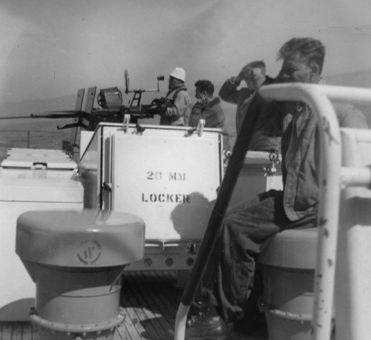 |
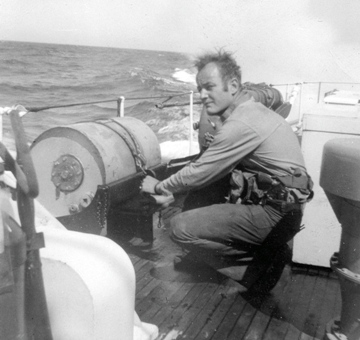 |
The 20mm Oerlikon being fired off the stern of the CG-83411 and a sailor at the starboard side depth charge position.
(Photos by Bob McCarty) |
|
83 Footers were primarily assigned to anti-submarine patrols, as coastal convoy escorts, and to search and rescue operations. They were equipped with radar, sonar and underwater listening equipment.They were armed in a variety of ways usually with .30 caliber and .45 caliber machine guns, a 20 mm Oerlikon cannon, and four small depth charge racks, one on the port and starboard sides of the aft deck, and two off the stern. Later in the war some were equipped with "Mousetrap" anti-submarine launchers.
 |
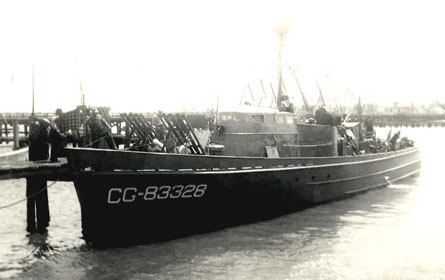 |
Many 83 Footers on anti-submarine duty were equipped with rocket-propelled "Mousetrap" rail mounted launching systems.These forward throwing weapons, similar to "hedgehog" rockets would each launch a pattern of four underwater explosives that were designed to detonate on contact with a submarine, instead of exploding at a pre-determined point like a depth charge.
(uscg83footers.org ) |
|
83 Footers are sometimes confused with PT (patrol torpedo) boats. While these small cutters resembled PT boats in profile, at 83 feet there were longer than the 78 to 80 foot length of WWII PT boats. Their hulls were constructed of smooth heavy wooden strakes compared to the light plywood skin of the PT boats.They were run by two gasoline engines and screws whereas the PTs had three, and they had about half the speed of a PT boat.83 Footers carried depth changes while the PTs carried torpedoes. The two boats were designed and armed for very different missions.
From radio and deck log records we have learned of three specific 83 Footers that served as escorts to the Pequot during 1943-44, the CG-83447(ex CG-488) and CG-83410 which were both stationed out of Boston, and the CG-83520 which was stationed out of Charleston, South Carolina.
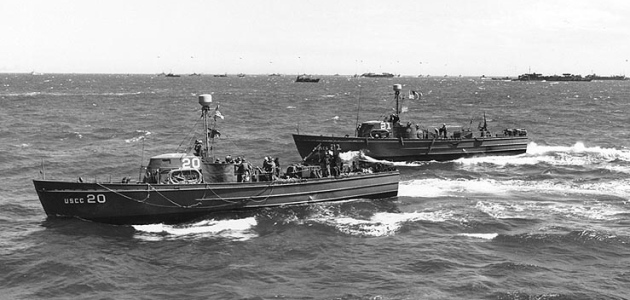 |
83 Footers USCG-20 and 21 off the coast of Normandy June 1944
(National Archives and Records Administration 26-G-3743) |
We've learned that after escorting Pequot, 83 footer CG-83447 became USCG-40 and saw action during the Normandy invasion as part of the 60 ship Rescue Flotilla 1 "Matchbox Fleet" which saved the lives of more than one thousand soldiers on D-Day. See: http://www.uscg.mil/history/WEBCUTTERS/ResFlot1_Normandy_Photo_Index.asp
After service along the North Atlantic seaboard both CG-83410 and CG-83520 were sent to the Philippines and stationed out of Manicani Island. A number of 83 Footers were moved to the war in the Pacific to serve as rescue craft during the expected invasion of Japan. After the war all of the 83 Footers that saw duty in the South Pacific were decommissioned and disposed of by the State Department and never returned to the states.
During WWII the Coast Guard had major coastal defense, harbor defense, lighthouse, and life saving missions throughout the Cape Cod, Massachusetts area on both the Atlantic and bay sides of the peninsula and throughout Boston’s harbor islands. As part of her duties the Pequot helped support this major wartime effort often escorted by an 83-foot patrol boat including the CG-83520.
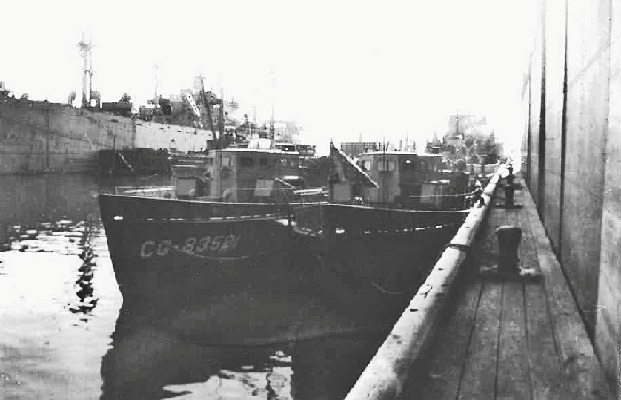 |
|
The CG-83521 (left) and Pequot escort the CG-83520 (right) tied-up in port (Thomas Flanagan Family) |
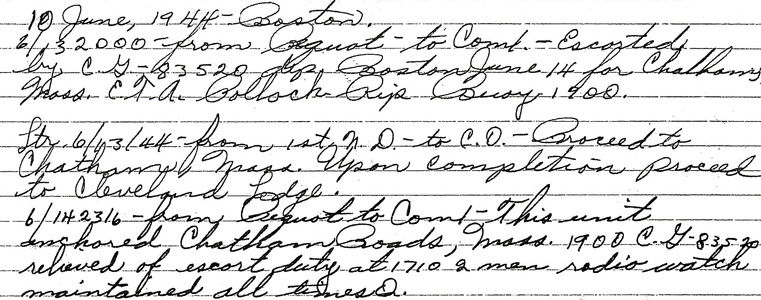 |
|
(US Coast Guard History Office 1991 |
From the 1944 Pequot ship movement record above we see that after being in port at Boston from June 10th that on June 13th at 2000 hours Pequot departed for Chatham Massachusetts escorted by the 83-footer CG-83520 with an Estimated Time of Arrival (ETA) on June 14th of 1900 hours at the Pollock Rip light ship buoy location.
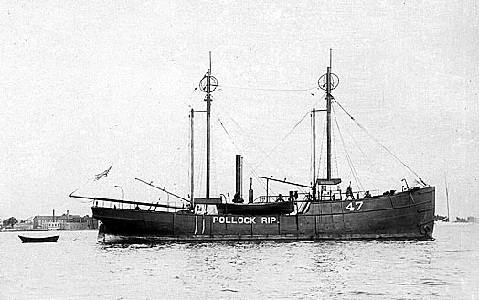 |
|
The Pollock Rip Lightship (KF-D Collection, Spinner Publications) |
Before and after WII the Pollock Rip Lightship (LV-110 / WAL-532 ) was stationed in coastal waters 3.5 miles East of Monomoy Beach near Chatham, Massachusetts and used as a guide for ships going through the Monomoy Passage which accessed the Eastern end of Nantucket Sound. During WWII the ship was transferred to the 3rd Naval District and assigned as the Vineyard Sound Station at Bay Shore, New York and used as an examination vessel at Woods Hole, Massachusetts. It’s peacetime location was only marked by a buoy which is where the Pequot headed on June 13th 1944.
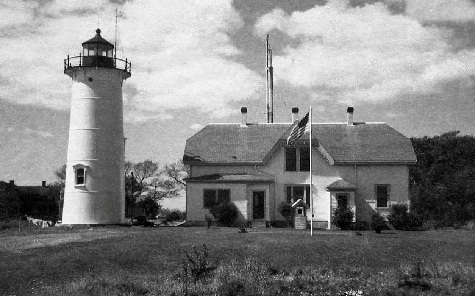 |
|
Chatham Light and Coast Guard Station 1943 (Ryder Family & USCG) |
Then later on June 13th the 1st Naval District directed the Commanding Officer of the Pequot to head to Chatham Mass for cable duty and then to proceed to the Cleveland Ledge Lighthouse.
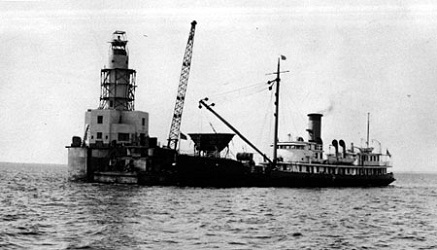 |
 |
| The Cleveland Ledge Lighthouse under construction in Buzzards Bay with a USCG tender on duty, and the completed light station later in the war. (Both USCG Photos) | |
Named after President Grover Cleveland the unusual 70’ foot tall Cleveland Ledge Lighthouse was built in the angular “art moderne” style of the 1930s and 40s and was the only lighthouse in Massachusetts ever built by the Coast Guard. Although automated in 1978 the light is still in service today as a Coast Guard operated navigation aid but under the National Historic Lighthouse Preservation Act of 2000 the building was sold to a private party in 2010 for $190,000.
On June 14th at 2316 hours Pequot radioed in that they were anchored at Chatham Roads harbor at that the CG-8350 was relieved of escort duty at 1710 hrs and that a 2-man radio watch would be maintained at all times.
This clearly documents the 83-footer CG-83520 as a Pequot escort and consistent with our research confirms that besides the ship’s secret indicator loop mission Pequot did a lot of routine cable work including running power and communication cables to lighthouses, life saving stations, and light ships.
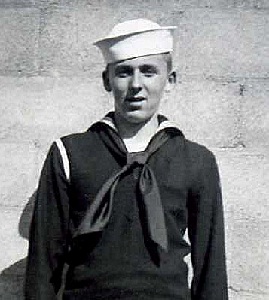 |
|
Motor Machinist Mate Thomas J. Flanagan Jr |
One of the sailors aboard the CG-8320 when she served as a Pequot escort was Motor Machinist Mate Thomas J. Flanagan Jr. For additional photos of the CG-8320 and to learn more about Tom’s diverse Coast Guard Service Click Here.
To learn more about the Coast Guard's 83 Footers go to:
http://uscg83footers.org and
http://www.cg83527.org/83footerhistory.htm.
See the Coast Guard’s website on the history of the 83 footers and their unique
contribution during WWII in both the Atlantic and Pacific theaters of operation
at:
http://www.uscg.mil/history/webcutters/83FtHistories.pdf
 |
Submarine Chaser 1297 off Cape Henry Virginia April 17th 1944.
SC-1297 was an identical sister ship to SC-1296 which escorted the
Pequot.
(U.S.
Naval Historical Center Photograph NH 96489) |
The Submarine Chasers or "Subchasers" of World War II were 110-112 foot long wooden ships that were quickly built at more than 50, mostly family owned, small boatyards on the Atlantic and Pacific coasts, around the Great Lakes region, and along the southern Gulf Coast of the United States. Referred to as a "Navy 496 Class" ship, they were designed, built, and armed specifically to meet the U-boat menace in the Atlantic and to counter the Japanese submarine threat in the Pacific theatre. By the end of the WWII more than 438 Subchasers were launched and commissioned.
With a typical crew of 3 officers and 24 enlisted men, they displaced 98 tons and had a range of 1,500 nautical miles at their normal cruising speed 12 knots. When pressed, their flank speed could approach 20 knots.
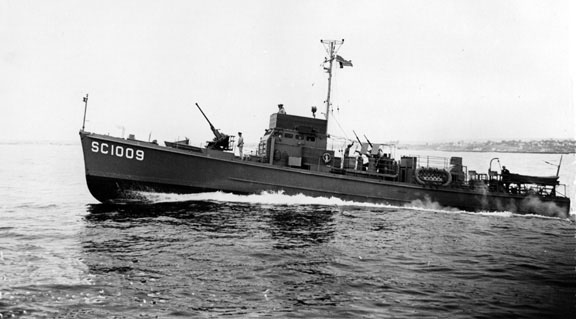 |
 |
| Submarine Chaser SC-1009 with forward cannon
and 20mm guns uncovered and ready. (National Archives and Records Administration) |
The
SC-1002 at flank speed off Cape Cod, Massachusetts September 1944. |
Considering their relatively small size, the SubChasers of WWII were very heavily armed. Up front they had either a single 40 mm Bofors cannon or a 3"/50 cannon. Most had three 20mm Oerlikon anti-aircraft guns, like the Pequot's, amidships, one twin 50 caliber machine gun aft, and two K-gun depth charge launchers. They carried fourteen 300 pound depth charges, and 2 sets of Mark 20 "mousetrap" rail anti-submarine rocket launchers each with four 7.2" projectiles.
Submarine Chasers escorted convoys, patrolled harbors, and were involved in hundreds of amphibious landings in Europe and in the Pacific. We have also learned that they escorted the Pequot during cable operations.
 |
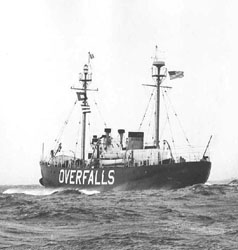 |
From the SC-1296 Deck Log April 6th 1945.
(Deck
Log from NARA thanks to Dan Treadwell) |
Overfalls Lightship (LV-101). (US Coast Guard) |
Notations in the April 6th 1945 Deck Log of Submarine Chaser 1296 show that she escorted Pequot from Staten Island, New York to the USS Overfalls Lightship (LV-101) which was stationed off the Coast of New Jersey. Pequot was most likely running communications cable out to Overfalls. Overfalls was anchored near the mouth of the Delaware Bay, roughly three miles east of Cape Henlopen and 8.5 miles southwest of Cape May. Four different lightships served that location from 1898 to 1960, when an automated buoy replaced the Overfalls which was anchored there from 1926 to 1951. See: http://www.lighthousefriends.com/light.asp?ID=453
The 1296 was built by W.A. Robinson Shipbuilding of Ipswich, Massachusetts and was commissioned on September 16th 1943 under command of Captain John W. Corbin LT(jg) and Executive Officer Charles L Carey LT(jg). Submarine Chaser 1296 spent its entire war career in the New York and Staten Island area. She was transferred to the Stapleton Coast Guard Base at Staten Island on August 14th 1945 as the Coast Guard Cutter Air Stork (WAVR 468). She was deactivated in placed in reserve on December 1st 1945 and fully decommissioned on January 20th 1947.
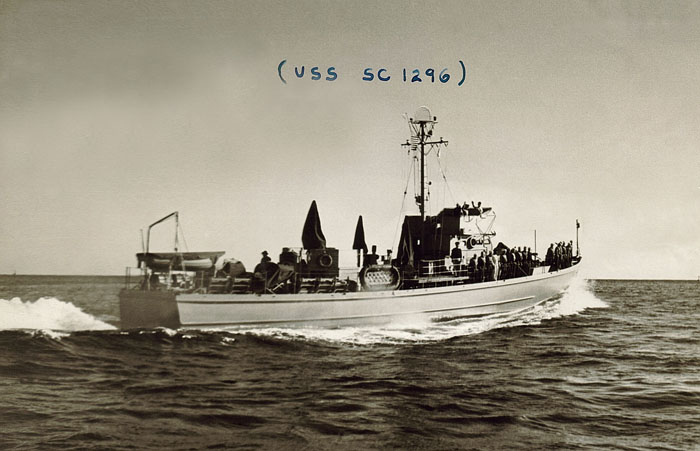 |
|
Subchaser 1296 underway during WWII. We can see much of the crew along the forward gunwale at parade rest probably for this photo. (Click to enlarge). (All SC 1296 photos courtesy Marilyn Chapoton). |
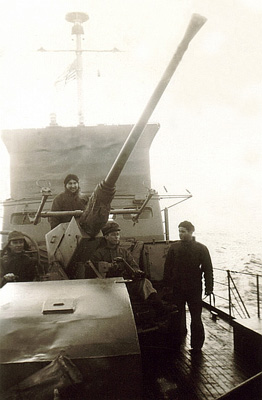 |
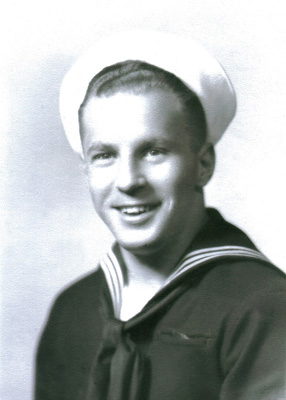 |
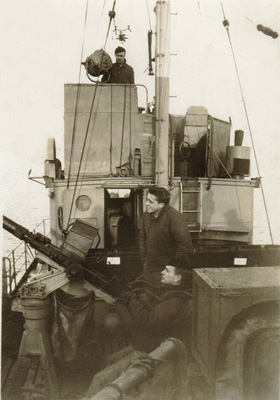 |
| The forward 40mm Bofors gun crew at sea. | Gene Chapoton served aboard SC 1296 during WWII. For additional photos and to learn more about Life Aboard the 1296 and Gene’s story Click Here. | One of the 20mm amidships gun crews. We see a sailor standing by the searchlight on the flying bridge directly atop the pilothouse. |
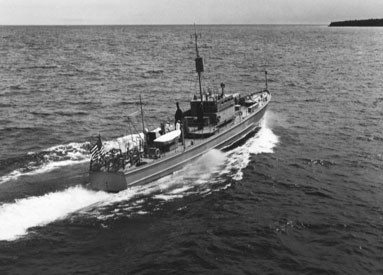 |
 |
SubChaser 537 at speed during sea trials. (National Archives and Records Administration). |
SC-745 at Hollandia, New Guinea 1944. (Ted R. Treadwell Photo). |
Ted R. Treadwell who was Commanding Officer of SC-648 in the South Pacific writes, "At sea the subchasers were rough-riding bucking broncos. Their narrow beam and shallow draft produced a constant roll - even in protected waters - which could cause queasiness for many experienced sailors. In heavy seas the tendency to roll combined with a violent pitching motion, causing the ship to corkscrew, precluding any chance for real rest or sleeping. Seasickness was common among subchaser sailors, particularly on the first day out after being in port."
To learn more about the wooden hulled Submarine Chasers of WWII go to: http://www.splinterfleet.org
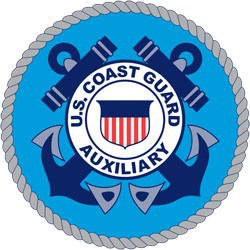 |
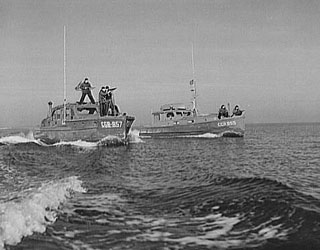 |
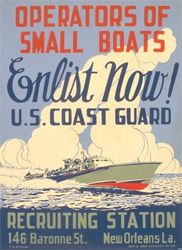 |
Two converted civilian craft (CGR) in WWII. (Library of Congress). |
(WPA War Department of Louisiana). |
With the prospect of war approaching, the U.S. Congress passed "The Coast Guard Reserve Act of 1939" which created the "Coast Guard Reserve", made up of unpaid volunteer U.S. citizens who owned motorboats or yachts. In February of 1941 further legislation created the military Coast Guard Reserve, which most Pequot sailors served in, and the volunteer citizen force was renamed the "US Coast Guard Auxiliary". Organized into "Flotillas" along all coasts of the United States, the Auxiliary played a vital role during World War II in harbor and coastal defense and with search and rescue operations.
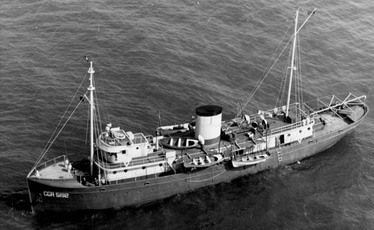 |
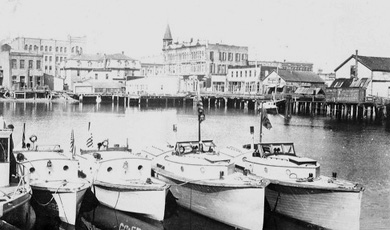 |
Private vessels of all types and sizes were part of the Coast Guard Auxiliary during WWII.
(US
Coast Guard). |
|
By 1945 the Coast Guard Auxiliary had 67,533 members, and 53,214 men and women (most of them Auxiliarists) were serving as temporary members of the Reserve. Still active today, the Coast Guard Auxiliary has more than 30,000 members who are involved in search and rescue operations, boating safety, harbor patrols, and environmental protection.
 |
|
Coast Guard officer C. Hann explains the use of signal flag pennants to new Auxiliary Flotilla 308 recruits in New Brunswick, New Jersey 1941. (US Coast Guard Photo) |
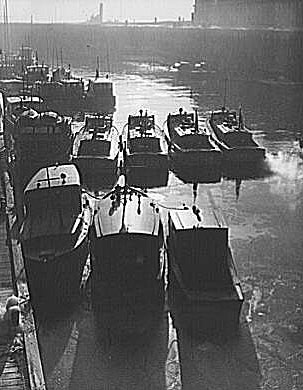 |
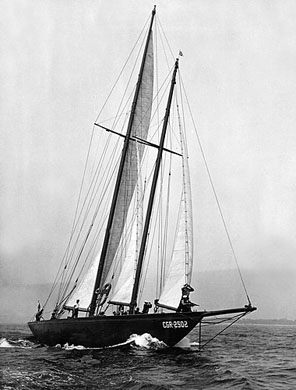 |
|
A group of private yachts
and boats tied up at the Boston Coast Guard Base during WWII. |
Most Americans had no idea that the situation on the Eastern seaboard at the beginning of the war was so dire that two masted private yachts, such as the CGR-2502 seen here in 1942, were pressed into service as the initial response against the German U-Boats. (Photo courtesy Jim Flynn) |
|
|
It hurt: Pequot Gunners Mate Roger Calamaio saw the conversion of some private boats. "The Coast Guard took over a lot of beautiful private yachts and after they brought them in we'd watch as they slapped that battleship grey paint all over those gorgeous mahogany decks and polished brass fittings. Oh, man, it hurt just to watch that!" |
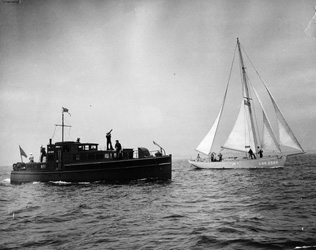 |
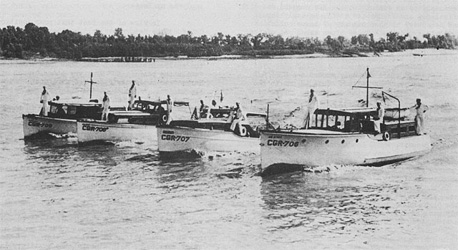 |
CGR-7242 and CGR-2520 circa 1942. (US Coast Guard). |
Four small converted yachts from an Auxiliary flotilla. (HyperWar Foundation). |
Hundreds of small motorboats, cabin cruisers, and even sailing yachts had numbers painted on their bows preceded by "CGR" for Coast Guard Reserve. They were armed in a variety of ways based upon their size, and early in the war many small boats had depth charges stowed awkwardly on their decks. Even though they were sometimes referred to as "the Putt-Putt Navy," they made up much of the early American response to the U-boat threat in coastal waters.
Radio logs indicate that the 60 foot Auxiliary CGR-868 escorted the Pequot to Bakers Island, Massachusetts during July of 1943, most likely for the installation or repair of communications cable.
|
|
|
The US Coast Guard Light Station on Bakers Island Massachusetts.
(US Coast Guard). |
|
Although we have not been able to locate a photo of the CGR-868 we've learned that she was assigned to the 1st Naval District which covered the U. S Coast from Rhode Island to Canada and she served from commissioning in September1942 until she left the flotilla in July 1944 and was disposed of in 1945.
THE CG-94001 - COAST GUARD AUXILIARY
Another of the US Coast Guard Auxiliaries was the CG-94001, built in 1931 and came from
the Great Lakes region. After acquisition by the 9th Coast Guard District on
August 6th 1942 she was fitted with small arms for coastal defense work along
the Atlantic seaboard during World War II where she served until July 4th 1945.
This 101 foot Auxiliary was used as a research vessel after the war out of
Oyster Bay, Long Island by the Sperry Gyroscope Company where she served as a
floating laboratory to test a wide range of new radar and navigation equipment.
Seaman 1st Class and Quartermaster Paul A Schlais served aboard the CG-94001
during the later part of WWII. These photos were contributed to the Pequot
Research Project by his granddaughter Heather in April of 2012.
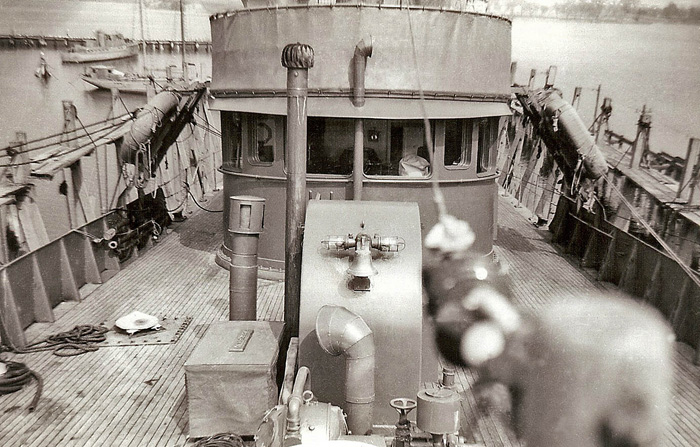 |
|
2. This view of the fo’cstle deck shows the bridge, two quick release life rafts, a forward companionway for access below decks, and a canvas wind screen and awning above the pilot house windows which stayed with the ship into the late 1940s as The Wanderer. (courtesy Paul A. Schlais Family) |
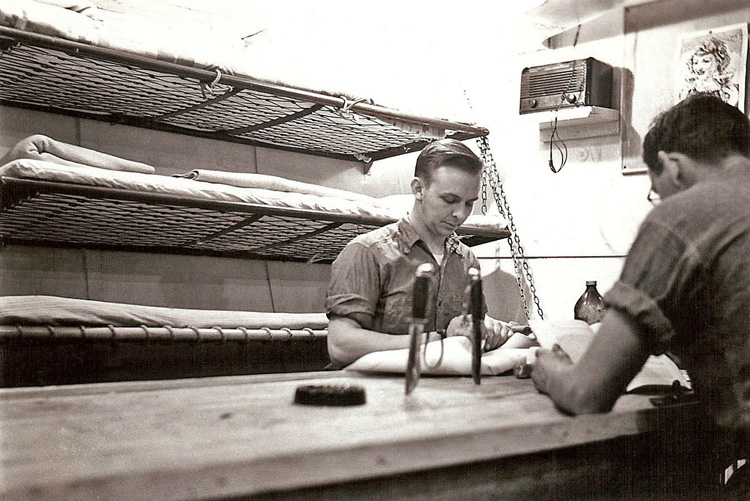 |
|
3. CG-94001 Quartermaster Paul A. Schlais doing some mending below decks while another sailor reads a book in the crew quarters. The knives they are showing off for the camera appear to be military issue Remington RH series combat knives. Notice how tight the space is between the bunks behind them. (courtesy Paul A. Schlais Family) |
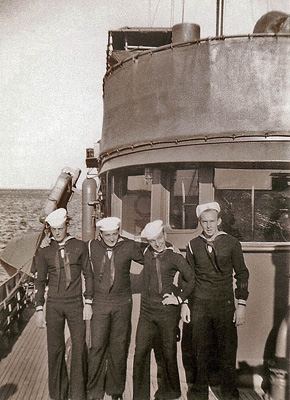 |
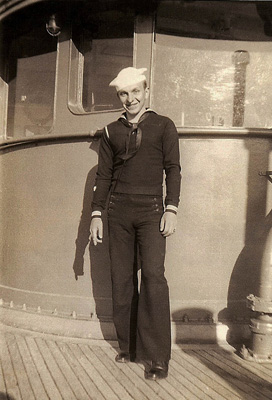 |
|
4a. From Left to Right sailors Bernardi, Melanson, John Iwanicki, and Paul A Schlais. (courtesy Paul A. Schlais Family) |
4b. Sailor John Iwanicki standing against the CG-94001’s pilot house (courtesy Paul A. Schlais Family |
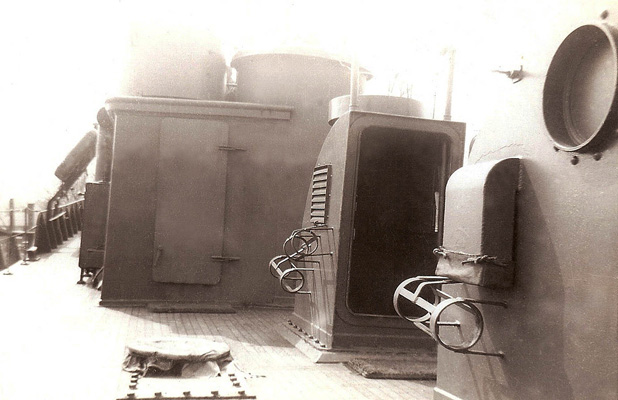 |
|
5. This port side view aft looking forward shows the two rear companionways which provided man access to the lower deck. Similar to the Pequot’s fo’cstle companionway which led to the forward crew quarters these covered doorways were provided with water tight doors so they could be sealed up when the deck was awash in heavy seas. (courtesy Paul A. Schlais Family) |
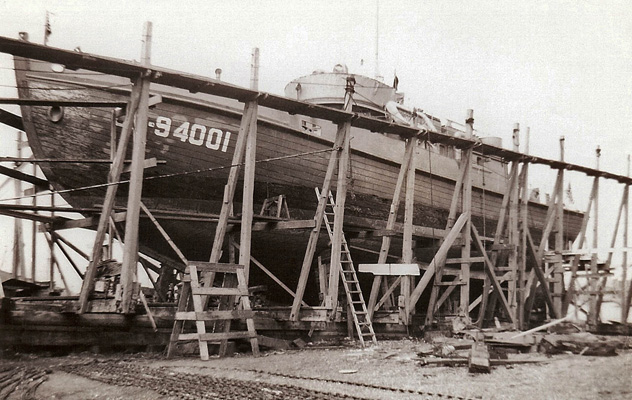 |
|
6. After some tough years at sea we see the CG-94001 high and dry while her hull undergoes some maintenance. The ship must still be commissioned as the union jack is flying at the bow and the American flag remains proudly flying at the stern. Circa 1944. (courtesy Paul A. Schlais Family) |
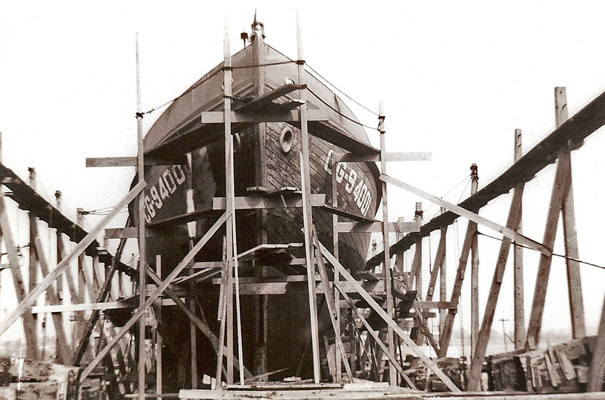 |
|
7. It appears in these photos that old paint and barnacles are being scrapped off the ships hull in preparation for a new paint job. Circa1944. (courtesy Paul A. Schlais Family) |
A number of radio log entries document that during the summer of 1943 Pequot
was escorted by the CG-94001 particularly around Portland, Bear Island, and
Southwest Harbor, Maine.
|
|
 |
Bear Island Light Station.
(US Coast Guard). |
Portland Head
Light, Maine (Library of Congress). |
The CG-94001 was featured as "The Smartest Ship Afloat!" in the April 1947 issue of Popular Mechanics magazine.
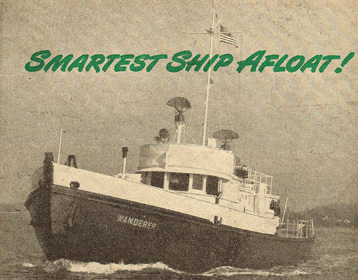 |
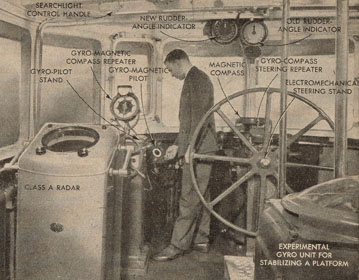 |
By 1947 the CG-94001 was a research vessel re-named "The Wanderer".
(Popular
Mechanics Magazine April 1947). |
|
 |
The former Pequot Escort CG-94001 was used to test a variety of navigation systems.
(Popular Mechanics Magazine April 1947). |
To learn more about the history of the US Coast Guard Auxiliary during WWII go to:
http://www.uscg.mil/auxiliary/administration/aux-history.asp
and
http://www.ibiblio.org/hyperwar/USCG/XIX-Auxiliary/index.html
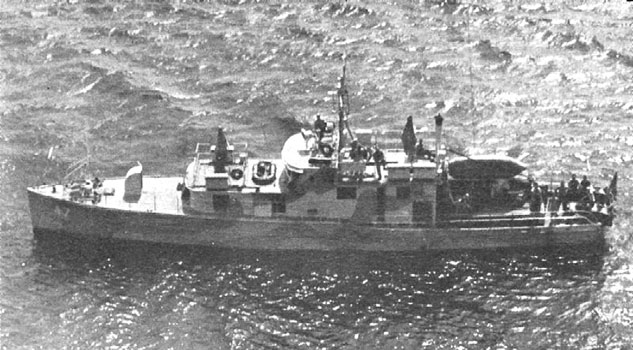 |
The USS Patriot
II (Pyc-47) August 13th 1944. (NavSource
Naval History. Photo by Gunter Krebs). |
Records indicate that in late January of 1944 Pequot departed Provincetown, Rhode Island bound for Boston escorted by the USS Patriot (PYc-47). The "PYc" stood for "Patrol Yachts Converted" and was a special designation for a particular type of Naval yacht that served doing coastal defense work during WWII. This patrol boat was armed with 20mm Oerlikon cannons and depth charges.
It is interesting to follow the history of how this ship came from private ownership before WWII and served in a variety of capacities for the US Navy before being returned to the same owner after the war:
The USS Patriot (PYc-47), formerly the Katoura, was built in 1930 by the Herreshoff Manufacturing Company in Bristol, Rhode Island and purchased by the United States Navy, for $1.00 from Mr. A. Loomis of New York City on September 20th 1940. She was converted for Navy service as a Submarine Chaser at the Greenport Basin and Construction Company at Greenport, New York and designated PC-455 on November 4th 1940. She was placed in service on February 27th 1941. On March 1st 1941, PC-455 departed New York City for Boston, Massachusetts where she reported for duty in the 1st Naval District. There she conducted coastal patrol assignments as PC-455 until June 16th 1943 when she was re-named Patriot and designated as PYc-47. As the Patriot she continued her patrols until placed out of service on September 28th 1944. She was then laid up at Quincy, Massachusetts awaiting delivery to the Maritime Commission and struck from the Naval Vessel Register on October 14th 1944. She was turned over to War Shipping Administration on March 14th 1945 and then sold back to her former owner for the initial purchase price of $1.00. |
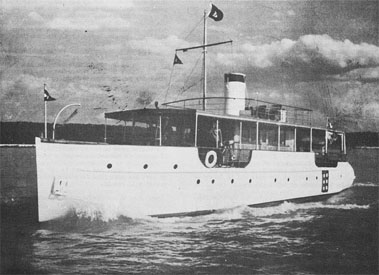 |
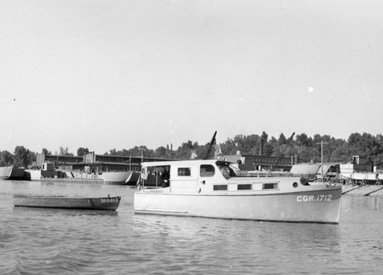 |
Coastal Yachts of all types were part of the Navy and Coast Guard reserve fleets during WWII.
(Photo, left: HyperWar Foundation - Patrick Clancey. Photo, right: Jim Flynn). |
|
Research by Chip Calamaio and Richard Walding with Special Thanks to Ken Liden, Ted Treadwell, Daniel Treadwell, Lawrence Levine, Jim Flynn, and Charlie Sproule
Every effort has been made to trace and acknowledge copyright. The authors would welcome any information from people who believe their photos have been used without due credit. Some photos have been retouched to remove imperfections but otherwise they are true to the original.
FEEDBACK
If you have comments or queries specifically
about the Pequot or her Escort Ships, please contact
Chip Calamaio
chipaz@cox.net, Phoenix, Arizona,
USA. (H) 602-279-4505.
Click here to go to the Pequot Main Page.
Research and design: Chip Calamaio and Richard Walding